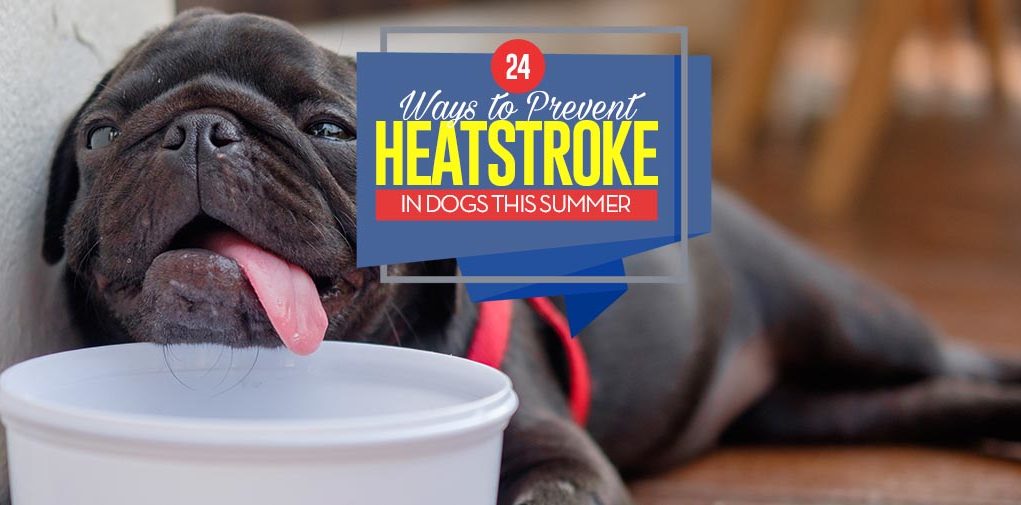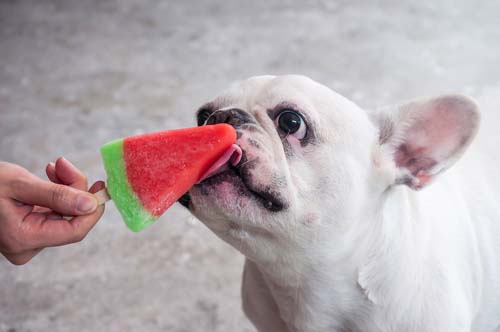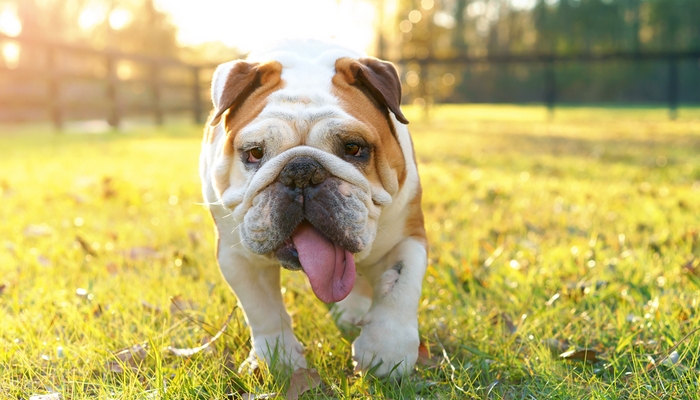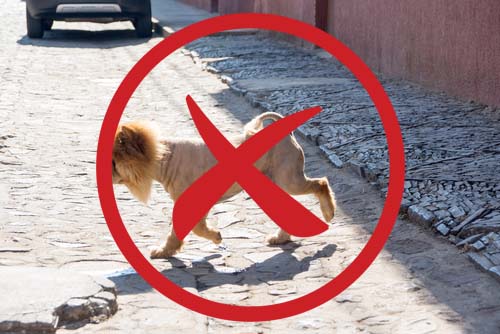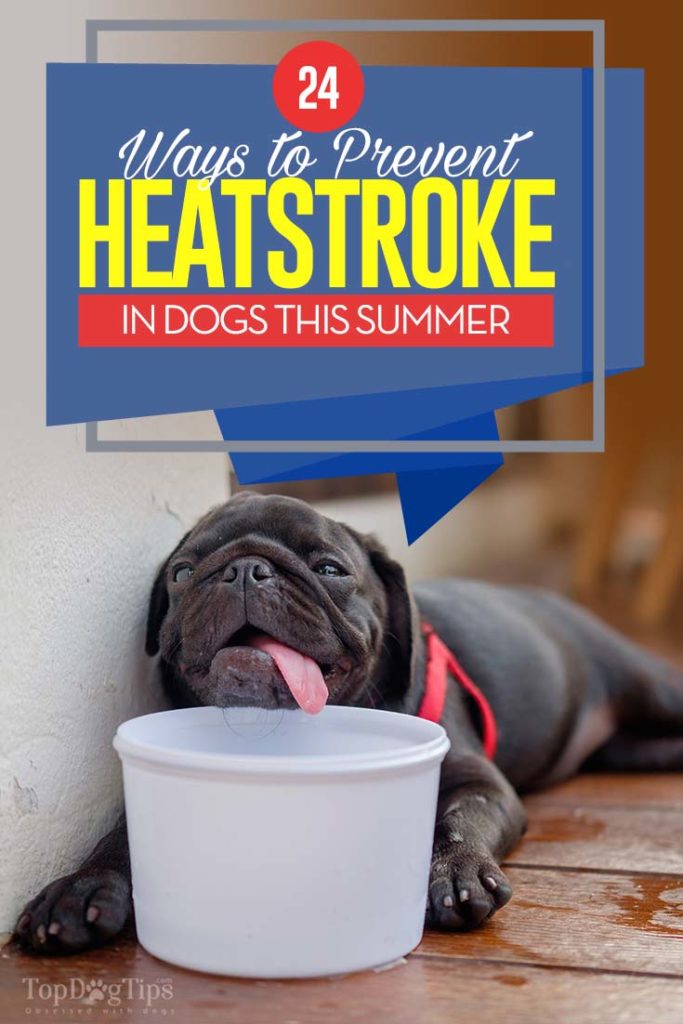Summer heat is in full swing, and so are summer dangers for dogs: heat exhaustion and heatstroke. When temperatures get this high, heatstroke in dogs becomes a commonly seen health problem in vet clinics. This condition could be life threatening to your pet.
Table of Contents
- 24 Ways to Prevent Heatstroke in Dogs
- 1. Pay Attention to Your Dog’s Health
- 2. Get a Dog Pool
- 3. Don’t Leave Your Dog Outside
- 4. Restrict Your Dog’s Exercise Outdoors
- 5. Use Cooling Vests for Dogs
- 6. Time Walking with Sunrise and Sundown
- 7. Do NOT Muzzle Your Dog
- 8. Access to Clean Water
- 9. Temperature Controlled Accommodations
- 10. Never Leave Your Dog in the Car
- 11. Buy a Cooling Mat for Dogs
- 12. Address Overheating Directly
- 13. Uncontrollable Symptoms of Overheating
- 14. Keep Sick Dogs Indoors
- 15. Always Be Aware of the Heat
- 16. Offer Your Dog Icy Treats
- 17. Use Window Shades in Your Car
- 18. Have a Backup Plan for Power Outages
- 19. Take Note of Your Dog’s Breed
- 20. Protect the Dog's Paws
- 21. Choose Cooler Areas for Walking
- 22. Do NOT Shave Your Dog
- 23. Use Cooling Bandanas for Dogs
- 24. Avoid ALL Strenuous Exercise
Summer Dangers for Dogs
The human body is programmed to cool itself through sweating, but dogs don't have the same ability. Instead, dogs pant. This allows their bodies to circulate air for a cool-down.
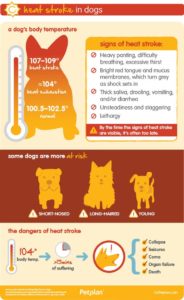
However, when temperatures become too extreme (100° F and up), panting cannot dissipate heat quickly enough, and the danger of heat stroke creeps up. Multiple studies show that the treatment for dogs that suffer from a heatstroke is complex, expensive and not always successful.
Other studies show that heatstroke in dogs results in serious complications and a near 50% fatality rate despite appropriate treatment. The higher the dog's temperature and the longer it takes for them to get treatment, the worse the outcome will be.
Environment also matters. When summer temperatures are high, everything around is hotter for the dog, like the asphalt the dog's walking on. For example, if it's 86° F degrees outside, then it becomes 135° F on asphalt.
“But even in relatively mild temperatures, burns to a pet’s pads can result if forced to walk on the hot surface.” – Dr. Raelynn Farnsworth, DVM (source)
To protect the dog's paws from the asphalt heat, many pet owners choose different paths to walk or protect the dog's paws with dog shoes or paw protection waxes.
Know How Well Your Dog Can Tolerate the Heat
Some breeds (mostly short-nosed brachycephalic like Bulldogs) are at a greater risk of heat stroke and heat exhaustion. Overweight and obese dogs are also more likely to overheat quicker. Even dogs that exercise regularly are still at the mercy of the heat and will become overheated quickly when the temperatures are simply too high for them:
“The perfect example of this is a dog who goes to the dog park on a nice, warm, spring day when they have not [been] all winter, and they play [with a] Frisbee [disk] and run more than normal.” – Dr. Stacy Eckman, DVM (source)
Heat stroke occurs when the generation of heat exceeds the dog body's ability to dissipate it. This is a serious condition that can may result in the following:
- vascular damage
- kidney damage
- liver damage
- gastrointestinal damage
- dysfunction in the central nervous system
Prevention is more effective than the cure. Ensure your dog is able to stay cool in the heat. If you suspect that your pet is overheating, take measures to cool him down and potentially seek medical treatment immediately.
24 Ways to Prevent Heatstroke in Dogs
1. Pay Attention to Your Dog’s Health
Know whether your dog has a predisposed condition that could increase his risk of heat exhaustion or other side effects of summer's heat. These conditions include heart disease, old age, being overweight, having respiratory conditions, or being a brachycephalic breed.
For example, a senior dog with heart disease can withstand no more than quick potty breaks outdoors on summer hot afternoons. Longer periods outdoors will strain their heart and cause breathing difficulties for your older canine.
2. Get a Dog Pool
When the temperatures reach 90+ degrees in summer, nothing will cool us faster and is more pleasurable than submerging the body into cool water. But even if you don't have a pool in your backyard, fortunately for your dog, you can still get him a dog swimming pool and fill it will “liquid relief” from summer's heat.
There are plenty of swimming pools for dogs that are designed specifically to help cool off our pets and sustain the damage and scratches. Some of those dog pools are even shaped like a bone. Place it in a shade, and your dog will be forever grateful.
If a full-on swimming pool isn't an option, something like a paddling pool for dogs (similar to those you'd get for kids to play) is another good way to cool off your dog in summer; however, paddling pools are more likely to be ripped apart quicker.
3. Don’t Leave Your Dog Outside
Never leave your dog outside in the heat for any period. This is a common cause of heat strokes in dogs, many dogs died from this. This means that “outside dogs” should be brought inside or given temperature controlled accommodations. This also means that potty visits should be kept short and dogs should not be left outdoors to play.
For example, even in the “shade”, a dog in your backyard can quickly overheat. Your dog’s natural body temperature is around 102 degrees. As it gets warmer outside, it gets harder for your dog to lower their body temperature. Once the outdoor temperature reaches your dog’s internal temperature, there is no way for your dog to cool at all and they quickly succumb to heatstroke.
4. Restrict Your Dog’s Exercise Outdoors
When it’s hot or humid, do not push your dog’s exercise limits. It’s harder for your dog to cool down in hot and humid temperatures so they’re much more likely to overheat. Also, limit the time you exercise or play with your dog outside.
For example, your dog uses evaporation to cool down their body temperature when they pant. When the humidity is higher in the air, evaporation is much slower meaning that it takes longer for your dog to cool down. Too much exercise or play time in hot weather could result in heatstroke in dogs much quicker than you would suspect.
5. Use Cooling Vests for Dogs
The great invention that are cooling vests will allow you and your pet go outside for longer periods of time without running the risk of heat exhaustion and heat strokes.
Dog cooling vests are harnesses made specifically for dogs that provide exterior cooling. Most often these are used on working dogs that must be outdoors in any type of heat. Cooling vests are also useful for senior dogs and overweight dogs on cooler summer days.
6. Time Walking with Sunrise and Sundown
No matter the temperature outside, there's no way to completely avoid walking your dog every day. However, you can find the best times to walk your dog in summer.
To avoid summer's heat when walking dogs, walk them before the sun comes up or after the sun goes down. This allows walking surfaces and the air to cool down sufficiently. It's also much easier for you as you can stay outside longer.
Walking surfaces absorb the heat of the sun, so when the sun is at its hottest, walking surfaces absorb and maintain that heat for hours. Once the sun goes down, the ambient temperature and sun exposure have reduced enough to allow walking surfaces to cool.
7. Do NOT Muzzle Your Dog
In certain situations, muzzles for dogs are not only beneficial but even essential. However, when the summer temperatures hit the all-time high, avoid putting on a muzzle on your dog because it increases chances of heatstroke.
If your dog needs a muzzle to walk safely, seek other methods of exercise him, or use the above advice and find better times. A muzzle restricts your dog’s ability to pant and cool down, which could cause heatstroke in dogs very quickly.
Also, if your dog has some type of fear aggression and needs a muzzle, consider indoor activities during summer months instead. Activities like a game of hide and seek or fetch down a long hallway can help to safely burn off excess energy and stimulate your dog.
8. Access to Clean Water
Clean cool water keeps your dog hydrated but it also helps to keep their body temperature down so make sure it's always available.
A great way to do this is to wash and refill your dog’s water bowl a minimum of three times a day. For pet owners who don't have the time, automatic water fountains are the best solution, because they keep the water circulating, fresh and cold.
Contrary to the myth, icy water and even ice is also good for dogs and is not dangerous to them in regular conditions.
9. Temperature Controlled Accommodations
If you keep your dog in an area of the home that is not temperature controlled, change that. If there's no access to air conditioning, consider an in-window AC unit or at least a portable fan. There are plenty of cheap dog-friendly fans that will give your dog some relief from summer's heat.
If your dog usually sleeps in the garage, install an air conditioning unit for them or bring them inside the main part of your air conditioned home. For dogs that sleep in their dog crates, you can get a crate cooling fan to provide some relief.
10. Never Leave Your Dog in the Car
Whether it’s summer or winter time, leaving your dog in the car poses multiple dangers, but it's especially dangerous to leave a dog in a car when it's hot outside.
In warmer months starting in April, heatstroke in dogs can set in very quickly. For example, in May when it’s 70 degrees outside, it takes just 10 minutes for the temp to reach 100 degrees in the car, even with the windows cracked. Note that there are now laws making it illegal to leave dogs in cars.
11. Buy a Cooling Mat for Dogs
For dogs that struggle to maintain body temperature in summer, buy a cooling mat if you've already exhausted other options. These dog cooling mats are pressure activated and provide a cool padded surface where your dog can lie, and became one of the most popular ways to provide cool relief for dogs today.
Once your dog lies down, the mat begins to cool against their exposed underbelly and helps to bring down their body temperature more rapidly. Cooling mats vary in size and price and can be very beneficial for dogs with thick coats, elderly dogs, or dogs with health conditions. They are a simple and cheap way to prevent heatstroke in dogs.
12. Address Overheating Directly
If you notice signs of heat stroke in your dog, it’s important to address them right away before they escalate. Here's what you do if you suspect heat exhaustion and overheating in your pet:
- Immediately bring your dog into a cool area and if possible run cool (not cold) water over their coat.
- If you cannot get your dog into the bathtub, use cool wet towels on your dog’s underside to help them cool.
- Encourage your dog to drink.
- Use fans to help circulate air and cool your dog, but do not point fans directly at a panting dog as it can cause bloating.
Signs that your dog is overheating include panting, weakness, pale gums, disorientation, or labored breathing. Keep those in mind and when it's summer, make sure you're prepared in case your dog experiences heat exhaustion.
13. Uncontrollable Symptoms of Overheating
If your dog has symptoms of overheating that you are unable to control using the methods noted above, take them to the vet immediately.
Uncontrolled overheating is a sure sign that your dog needs medical intervention, do not delay. If left untreated, overheating can cause organ failure.
14. Keep Sick Dogs Indoors
If your dog is experiencing a fleeting illness like a tummy upset or even canine flu, keep them indoors. Sick dogs dehydrate very quickly and added weakness from illness can speed up the process of heatstroke.
For example, if your dog has eaten something that does not agree with their tummy, avoid your walk after sundown and do quick outdoor potty breaks instead.
15. Always Be Aware of the Heat
Many pet owners think that just because their pet is swimming, they will not suffer from a heatstroke. While the water can bring down your dog’s body temperature, the atmospheric temperature can still cause your dog to overheat.
For example: If your dog is in the pool during the summer, limit their swimming times to short 15-minute to 30-minute intervals and watch for signs of overheating.
16. Offer Your Dog Icy Treats
During particularly hot summer days, offer your dog icy treats or make dog ice cream to help them to cool down. Some dogs enjoy ice cubes, but if your dog doesn’t I find that freezing pieces of dog-safe fruit into water in ice cube trays works just as well! If you have a particularly picky pup, try all-natural juice watered down and frozen instead.
For example, if your dog has just been outside to potty and comes back inside panting and overheated, offer them icy treats to cool down faster.
17. Use Window Shades in Your Car
If you do have to travel with your dog during summer months, put up sun shades on the windows of your car. Most often used for babies, these shades keep direct sunlight off your dog and can easily be taken down when not in use.
You can also get a dog-friendly fan for cars that will keep your dog cool in case the regular car setup doesn't work or doesn't provide enough cold for the dog.
18. Have a Backup Plan for Power Outages
If your area is prone to power outages that may cause your home to become unbearably hot for your dog, have a backup plan. For example, consider installing a generator to keep a window air conditioning unit running or stay with friends until your power returns.
19. Take Note of Your Dog’s Breed
If your dog is a brachycephalic breed – if they have a short broad muzzle – they have a more difficult time regulating their body temperature and are more prone to respiratory difficulty. These breeds are more susceptible to heatstroke in dogs.
These dogs should spend considerably short periods outdoors and should be monitored closely for any signs of overheating. Overheating for brachycephalic breeds happens very quickly, so it’s important to be vigilant.
20. Protect the Dog's Paws
As mentioned above, summer's heat affects the environment and things like asphalt get way too hot for dogs way too quick. A rule of thumb is that the surface is often 20 F degrees hotter than the temperature outside.
The most common way to protect dog's paws are by using booties. However, if it's too hot, other options may be used, such as socks. If, however, it's too late and your dog has already burned his paws on hot asphalt, make sure to use paw balms to relieve the pain and speed up the healing process.
Protecting your dog's paws from hot surface will not only help prevent heatstroke in dogs but also keep your dog's feet healthy and in good condition.
21. Choose Cooler Areas for Walking
Even if you protect your dog's paws with dog booties or paw waxes, it's best to avoid hot areas and choose shade over burning sun every time.
When the temperature has cooled enough to walk your dog, try to stick to cooler areas to reduce the temperature further. For example, walk your dogs on a wooded path rather than on a sidewalk around your development.
22. Do NOT Shave Your Dog
Some dogs can benefit from a trim of their coat during summer months, but you should NEVER shave your dog’s coat completely, and we've already discussed all the reasons why shaving your dog for summer is bad.
Your dog’s coat not only keeps them warm in winter, but it also helps to regulate their temperature in summer! For example, your dog’s coat protects them from sunburn, and their undercoat helps to keep out excessive heat by insulating your dog’s body.
23. Use Cooling Bandanas for Dogs
Cooling bandanas can help dogs cool down much faster by providing skin contact with a cool pad. Equipping your pet with one will greatly reduce his chances of heatstroke in dogs. These bandanas are available from most pet stores during summer time and simply require freezing before use.
The bandana wraps around your dog’s neck like a towel might and can be reused. Cooling bandanas are helpful for during walks and after walks as well as for dogs that are feeling feverish as they provide rapid, instant, cooling. You can do the same thing with shirts by placing them in icy water first.
24. Avoid ALL Strenuous Exercise
Even if your dog is particularly healthy and spends a short period of time outside, you should avoid all strenuous exercise, play time and dog training.
For example, strenuous activities like running, playing fetch, or playing frisbee cause your dog’s body temperature to rise quickly. This means that only a few minutes of strenuous activity can result in overheating.
READ NEXT: 10 Safety Tips for Camping with Dogs


